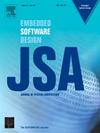Toward TinyDPFL systems for real-time cardiac healthcare: Trends, challenges, and system-level perspectives on AI algorithms, hardware, and edge intelligence
IF 4.1
2区 计算机科学
Q1 COMPUTER SCIENCE, HARDWARE & ARCHITECTURE
引用次数: 0
Abstract
Despite rapid advances in medical technology, cardiac diseases remain the leading cause of global mortality, with arrhythmias that pose significant diagnostic and treatment challenges. This survey presents a comprehensive review of 176 state-of-the-art contributions in machine learning (ML), federated learning (FL), TinyML, and hardware acceleration for efficient, real-time, and privacy-preserving cardiac diagnosis and care. Explores both software and hardware advancements, including differential privacy (DP), quantized neural networks, and FPGA (Field Programmable Gate Array)-based implementations optimized for edge devices and wearable devices. Key challenges, such as latency, energy constraints, adversarial robustness, and personalization, are systematically examined. The survey synthesizes solutions across algorithmic innovations, secure and adaptive FL frameworks, and neuromorphic and sparse architectures, especially FPGA-based solutions, for resource-aware inference and training. Informed by original research, it highlights emerging directions: AI-driven data mining, DP for quantized models, continual learning (CL) on the edge, FPGA-accelerators including quantized DNN, SNN, and Sparse architectures, tuneable/reconfigurable FPGA-based TinyDPFL, Multimodal heterogeneous FL, real-time adversarial detection via model watermarking. This work offers a unified system-level perspective bridging ML algorithms and edge AI hardware, guiding the development of scalable, adaptive, and trustworthy cardiac healthcare systems. Beyond surveying existing literature, it proposes forward-looking design principles to advance intelligent, secure, and practical digital cardiology.
面向实时心脏医疗的TinyDPFL系统:AI算法、硬件和边缘智能的趋势、挑战和系统级观点
尽管医疗技术进步迅速,但心脏病仍然是全球死亡的主要原因,心律失常对诊断和治疗构成重大挑战。本调查全面回顾了机器学习(ML)、联邦学习(FL)、TinyML和硬件加速方面的176项最先进的贡献,以实现高效、实时和保护隐私的心脏诊断和护理。探讨了软件和硬件的进步,包括差分隐私(DP),量化神经网络,以及针对边缘设备和可穿戴设备优化的基于FPGA(现场可编程门阵列)的实现。关键的挑战,如延迟,能量约束,对抗鲁棒性和个性化,系统地检查。该调查综合了算法创新、安全和自适应FL框架、神经形态和稀疏架构的解决方案,特别是基于fpga的解决方案,用于资源感知推理和训练。在原始研究的基础上,它强调了新兴方向:人工智能驱动的数据挖掘,量化模型的DP,边缘持续学习(CL),包括量化DNN, SNN和稀疏架构在内的fpga加速器,可调/可重构的基于fpga的TinyDPFL,多模态异构FL,通过模型水印的实时对抗检测。这项工作提供了一个统一的系统级视角,将机器学习算法和边缘人工智能硬件连接起来,指导可扩展、自适应和值得信赖的心脏医疗保健系统的开发。除了调查现有文献,它提出了前瞻性的设计原则,以推进智能,安全和实用的数字心脏病学。
本文章由计算机程序翻译,如有差异,请以英文原文为准。
求助全文
约1分钟内获得全文
求助全文
来源期刊

Journal of Systems Architecture
工程技术-计算机:硬件
CiteScore
8.70
自引率
15.60%
发文量
226
审稿时长
46 days
期刊介绍:
The Journal of Systems Architecture: Embedded Software Design (JSA) is a journal covering all design and architectural aspects related to embedded systems and software. It ranges from the microarchitecture level via the system software level up to the application-specific architecture level. Aspects such as real-time systems, operating systems, FPGA programming, programming languages, communications (limited to analysis and the software stack), mobile systems, parallel and distributed architectures as well as additional subjects in the computer and system architecture area will fall within the scope of this journal. Technology will not be a main focus, but its use and relevance to particular designs will be. Case studies are welcome but must contribute more than just a design for a particular piece of software.
Design automation of such systems including methodologies, techniques and tools for their design as well as novel designs of software components fall within the scope of this journal. Novel applications that use embedded systems are also central in this journal. While hardware is not a part of this journal hardware/software co-design methods that consider interplay between software and hardware components with and emphasis on software are also relevant here.
 求助内容:
求助内容: 应助结果提醒方式:
应助结果提醒方式:


